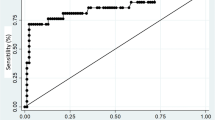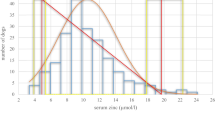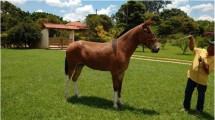Abstract
The purposes of this study were to determine normal value of glycated hemoglobin in Persian cats and to investigate its relation to fasting plasma glucose. Blood samples were collected from 67 clinically healthy adult Persian cats (32 males and 35 females). After separation and washing of red blood cells, hemolysate was prepared and subjected to weak cation exchange chromatography for determination of glycosylated hemoglobin. Glucose was measured in fasting plasma samples (after 10–12 h of fasting) using glucose oxidase method. Glycosylated hemoglobin % in the studied cats was 1.56 ± 0.47 in males and 1.61 ± 0.52 in females. Fasting plasma glucoses were 88.3 ± 10.2 and 90.8 ± 11.5 mg/dl in males and females, respectively. Glycosylated hemoglobin % and plasma glucose strongly correlated together (r = 0.79, p < 0.001). Three cats with persistent high fasting plasma glucose showing glycosylated hemoglobin percentage of 2.6, 2.8, and 2.9 % which exceeded the upper limit of the normal value obtained in this study were found. We concluded that glycosylated hemoglobin % is a good indicator of fasting plasma glucose, and its determination can be considered as a method for diabetes screening in Persian cats. Considering three cats with persistent high fasting plasma glucose and glycosylated hemoglobin percent, we concluded that glycosylated hemoglobin percent could be a good biochemical test for screening or diagnosis diabetes in cats.
Similar content being viewed by others
References
Abraham EC, Cope ND, Braziel NN et al (1979) On the chromatographic heterogeneity of human fetal hemoglobin. Biochim Biophys Acta 577:159
Akol KG, Waddle JR, Wilding P (1992) Glycated hemoglobin and fructosamine in diabetic and nondiabetic cats. J Am Anim Hosp Assoc (USA)
Al-Ali AK, Rehaimi A, Saba R et al (1990) A comparative study of glycosylated haemoglobin level in the Arabian camel (Camelus dromedarius) during different seasons. Comp biochem physiol B Comp biochem 96:821
Alayash AI, Wilson MT (1987) Levels of glycosylated haemoglobin in the Arabian camel (Camelus dromedarius). Comp Biochem Physiol B 86:343–345
Ardia DR (2006) Glycated hemoglobin and albumin reflect nestling growth and condition in American kestrels. Comp Biochem Physiol A 143:62–66
Bunn HF (1981a) Evolution of mammalian hemoglobin function. Blood 58:189
Bunn HF (1981b) Evaluation of glycosylated hemoglobin diabetic patients. Diabetes 30:613–617
Burtis CA, Ashwood ER (1999) Tiets textbook of clinical chemistry, 3rd edn. Saunders, Philadelphia
Delack JB, Stogdale L (1983) Glycosylated hemoglobin measurement in dogs and cats: implications for its utility in diabetic monitoring. Can Vet J 24:308–311
Elliott DA, Nelson RW, Feldman EC et al (1997) Glycosylated hemoglobin concentration for assessment of glycemic control in diabetic cats. J Vet Intern Med 11:161–165
Elliott DA, Nelson RW, Reusch CE et al (1999) Comparison of serum fructosamine and blood glycosylated hemoglobin concentrations for assessment of glycemic control in cats with diabetes mellitus. J Am Vet Med Assoc 214:1794–1798
Gabbay KH (1979) Glycosylated hemoglobins: increased glycosylation of hemoglobin A in diabetic patients. Diabetes 28:337–340
Gabbay KH, Sosenko JM, Banuchi GA et al (1979) Glycosylated hemoglobins: increased glycosylation of hemoglobin A in diabetic patients. Diabetes 28:337–340
Goossens MMC, Nelson RW, Feldman EC et al (1998) Response to insulin treatment and survival in 104 cats with diabetes mellitus (1985–1995). J Vet Intern Med 12:1–6
Hasegawa S, Sako T, Nea Takemura (1992) Glycated hemoglobin fractions in normal and diabetic cats measured by high performance liquid chromatography. J Vet Med Sci 54:789–790
Higgins PJ, Garlick RL, Bunn HF (1982) Glycosylated hemoglobin in human and animal red cells. Role of glucose permeability. Diabetes 31:743–748
Hoenig M, Ferguson DC (1999) Diagnostic utility of glycosylated hemoglobin concentrations in the cat. Domest Anim Endocrinol 16:11–18
Hoyer-Ott MA, Reusch C, Minkus G (1995) Glykosylierte Ha¨moglobine (Ghb) bei der Katze: Affinitatschromatographische Bestimmung bei gesunden, permanent (Diabetes mellitus) und passager hyperglyka¨mischer Katzen. Tierarztl Prax 23:155–161
Jenks JA, Lochmiller RL, Leslie DM (1991) Glycosylated hemoglobin as a stable alternative to serum glucose in white-tailed deer. J Wildl Dis 27:502
Jovanovic L, Druzin M, Peterson CM (1981) Effect of euglycemia on the outcome of pregnancy in insulin-dependent diabetic women as compared with normal control subjects. Am J Med 71:921
Latimer KS, Mahaffey EA (2003) Veterinary laboratory medicine. Clinical pathology, 4th edn. Iowa State, Ames
Loste A, Marca MC (2001) Fructosamine and glycated hemoglobin in the assessment of glycaemic control in dogs. Vet Res 32:55–62
Milne E (1989) Diabetes mellitus. Pract 11:105–109
Peterson KP, Pavlovich JG, Goldstein D et al. (1998) What is hemoglobin A1c? An analysis of glycated hemoglobins by electrospray ionization mass spectrometry. Am Assoc Clin Chem 1951–1958
Rand JS, Bobbermien LM, Hendrikz JK et al (1997) Over representation of Burmese cats with diabetes mellitus. Aust Vet J 75:402–405
Richter NA (1986) Percentage of glycosylated hemoglobin and serum concentration of glucose in the blood of Japanese macaques and in three exotic ruminant species. Am J Vet Res 47:1783–1784
Shahbazkia HR, Nazifi S (2005) Determination of glycated haemoglobin in horses by cation exchange chromatography. Comp Clin Pathol 14:168–170
Shahbazkia HR, Nazifi S (2008a) Determination of glycated haemoglobin (HbG) and its correlation with plasma glucose in Iranian fat-tailed sheep and lamb. Online J Vet Res 12:7–13
Shahbazkia HR, Nazifi S (2008b) Glycated haemoglobin (HbG) as a stable indicator of blood glucose status in ostrich. Comp Clin Pathol 17:9–12
Taketa F, Mauk AG, Lessard JL (1971) Chain amino termini of the cat hemoglobins and the response to 2, 3-diphosphoglycerate and adenosine triphosphate. J Biol Chem 246:4471–4476
Acknowledgments
This work has been supervised and supported by the research council of the Shahrekord University, Iran.
Author information
Authors and Affiliations
Corresponding author
Rights and permissions
About this article
Cite this article
Bakhtiari, H., Torkian, M., Shahbazkia, H.R. et al. Glycosylated hemoglobin is a good indicator of blood glucose status in Persian cats. Comp Clin Pathol 22, 1225–1228 (2013). https://doi.org/10.1007/s00580-012-1554-y
Received:
Accepted:
Published:
Issue Date:
DOI: https://doi.org/10.1007/s00580-012-1554-y




